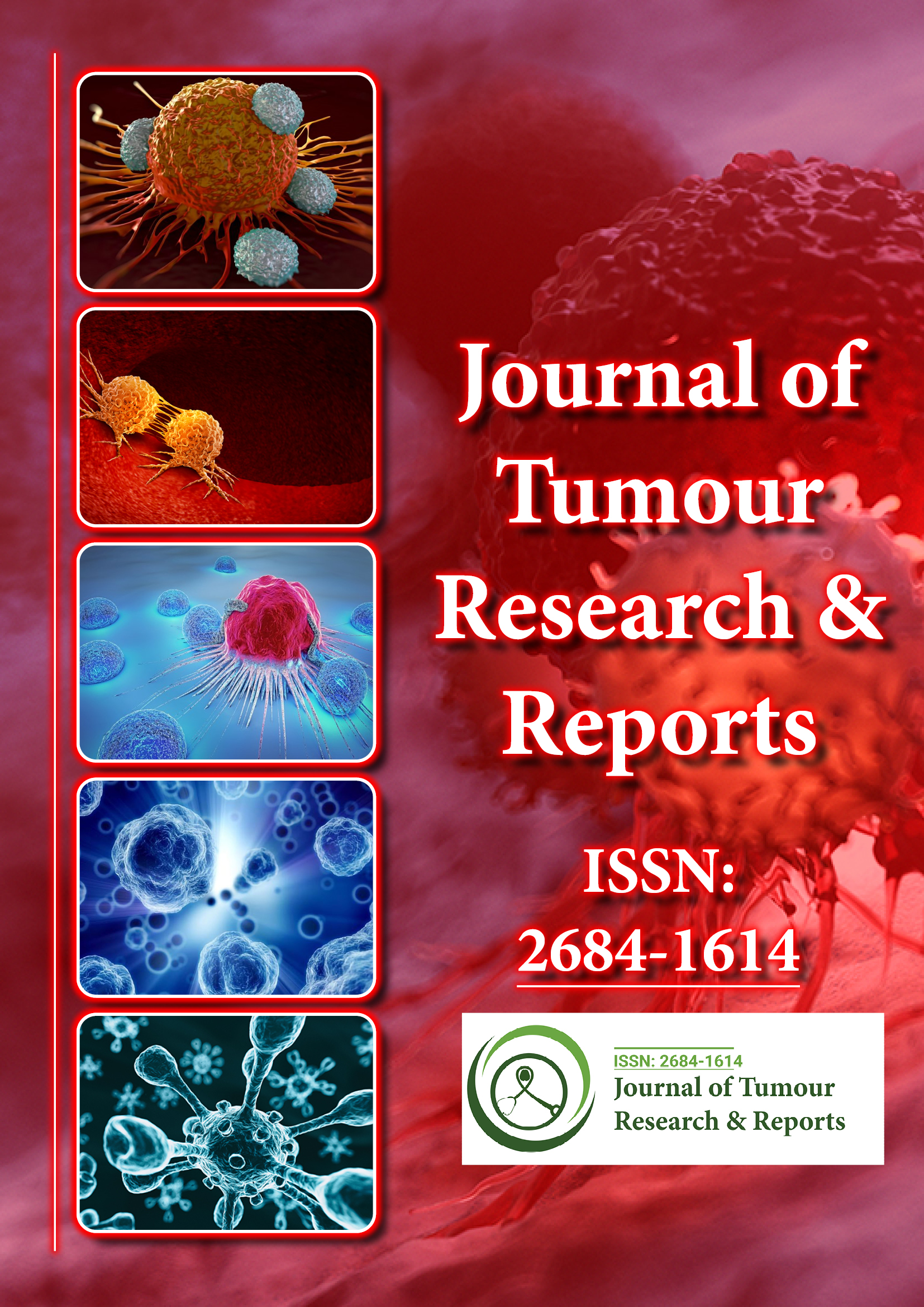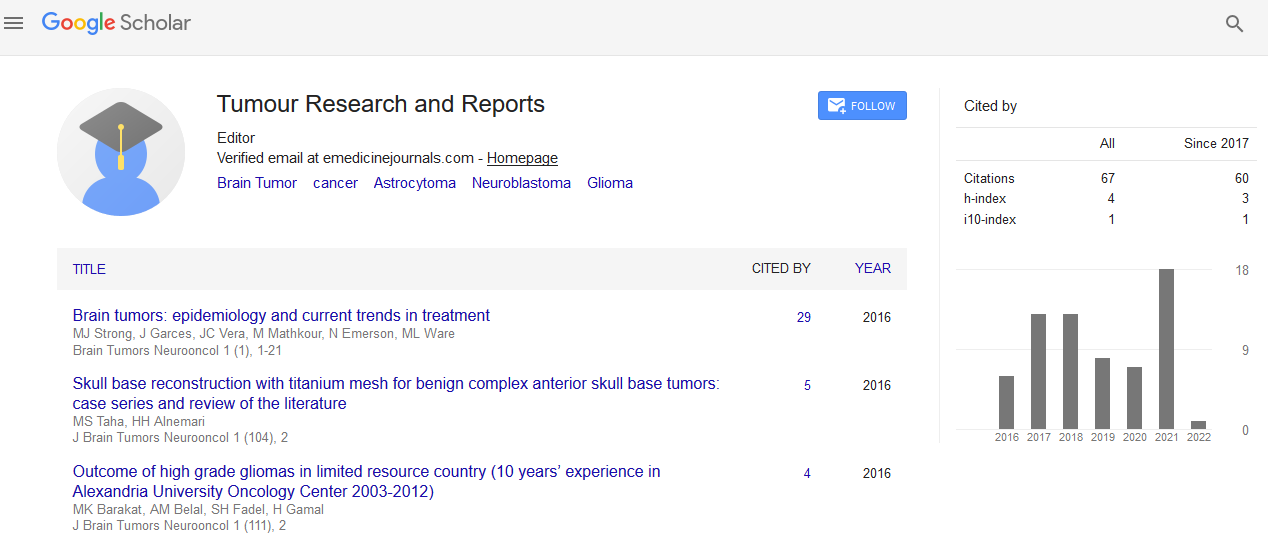Indexed In
- RefSeek
- Hamdard University
- EBSCO A-Z
- Google Scholar
Useful Links
Share This Page
Journal Flyer

Open Access Journals
- Agri and Aquaculture
- Biochemistry
- Bioinformatics & Systems Biology
- Business & Management
- Chemistry
- Clinical Sciences
- Engineering
- Food & Nutrition
- General Science
- Genetics & Molecular Biology
- Immunology & Microbiology
- Medical Sciences
- Neuroscience & Psychology
- Nursing & Health Care
- Pharmaceutical Sciences
Short Communication - (2023) Volume 8, Issue 4
Advancements in Soft Tissue Sarcoma Care: Surgical Techniques and Radiotherapy Strategies
Michelle Shirver*Received: 14-Nov-2023, Manuscript No. JTRR-23-24229; Editor assigned: 17-Nov-2023, Pre QC No. JTRR-23-24229 (PQ); Reviewed: 01-Dec-2023, QC No. JTRR-23-24229; Revised: 08-Dec-2023, Manuscript No. JTRR-23-24229 (R); Published: 15-Dec-2023, DOI: 10.35248/2684-1614.23.8:208
Description
Soft Tissue Sarcomas (STS) represent a diverse group of rare malignancies that arise from connective tissues, including muscles, nerves, and blood vessels. The treatment of STS involves a multidisciplinary approach, with surgery and radiotherapy playing pivotal roles in managing this complex disease.
Understanding soft tissue sarcoma
Soft tissue sarcomas encompass a broad spectrum of histological subtypes, each with its unique characteristics and clinical behaviour. While surgical resection remains as a fundamental of treatment, the complexity lies in achieving a balance between local controls and preserving function [1]. The location, size, grade, and histological subtype of the tumor all contribute to the decision-making process, necessitating a personalized approach for each patient.
The role of surgery in resection and reconstruction
Surgery serves as the primary modality for local control of soft tissue sarcomas. The goals of surgical interventions are to achieve complete resection with negative margins (R0 resection) while minimizing functional impairment. The intricacies arises while dealing with tumours in anatomically challenging locations, such as those adjacent to vital structures or in proximity to neurovascular bundles [2].
Advancements in surgical techniques, including limb-sparing procedures and reconstructive surgery, have revolutionized the management of extremity sarcomas. Limb-sparing surgeries aim to remove the tumor while preserving the affected limb's functionality, often involving the meticulous excision of the tumor followed by reconstruction using grafts, flaps, or prosthetics [3].
In cases where achieving negative margins is challenging, owing to the tumour's proximity to critical structures, neoadjuvant radiotherapy may be employed to facilitate more extensive resections during surgery [4]. This approach underscores the collaborative nature of treatment modalities in soft tissue sarcoma management.
Radiotherapy as an adjuvant and neoadjuvant strategy
Radiotherapy plays a significant role in the multidisciplinary management of soft tissue sarcomas, both as an adjuvant and neoadjuvant strategy [5]. Adjuvant radiotherapy is typically administered after surgery to eradicate residual microscopic disease and reduce the risk of local recurrence. The decision to use adjuvant radiotherapy is influenced by factors such as tumor size, grade, and margin status post-surgery.
In cases where achieving negative margins is challenging, neoadjuvant radiotherapy may be employed before surgery to shrink the tumor and facilitate more conservative surgical approaches [6]. This can be particularly beneficial in tumors located in anatomically sensitive are as, allowing for improved resectability while minimizing functional morbidity.
Challenges and advances in radiotherapy techniques
Despite the efficacy of radiotherapy, challenges persist in mitigating its impact on surrounding healthy tissues. Technological advancements in radiation therapy, including Intensity-Modulated Radiation Therapy (IMRT) and proton therapy, have aimed to enhance treatment precision and reduce collateral damage to adjacent structures [7].
IMRT allows for the precise delivery of radiation, shaping the dose distribution to conform to the tumor's contours while sparing normal tissues [8]. Proton therapy, with its unique physical properties, further refines this precision by delivering radiation in a controlled manner, minimizing radiation exposure to healthy tissues beyond the tumor.
The evolving landscape: Immunotherapy and beyond
As the field of oncology continues to evolve, immunotherapy has emerged as a potential approach for soft tissue sarcoma treatment. While the role of immunotherapy is more established in certain malignancies, ongoing research investigates its potential in sarcomas, either as an independent modality or in combination with surgery and radiotherapy [9].
Clinical trials exploring immune checkpoint inhibitors and adoptive T-cell therapies in soft tissue sarcoma are underway, presenting new opportunities for targeted and systemic interventions [10]. The integration of immunotherapy into the treatment model underscores the dynamic nature of soft tissue sarcoma research and investigates for more effective and altered therapeutic strategies.
Conclusion
The optimal management of soft tissue sarcoma necessitates a comprehensive and collaborative approach, integrating surgery and radiotherapy within a multidisciplinary framework. Advances in surgical techniques, radiotherapy modalities, and the exploration of novel immunotherapeutic strategies collectively contribute to refining treatment outcomes and minimizing the treatment-related morbidity.
As our understanding of the molecular and immunological support of soft tissue sarcomas deepens, the future developments anticipate more individualized and specific treatment modalities. The ongoing synergy between surgical innovation, radio therapeutic precision, and emerging immunotherapies signifies a dynamic era in soft tissue sarcoma management, encourages for the improved outcomes and enhanced quality of life for affected individuals.
References
- Dei Tos AP, Bonvalot S, Haas R. The key role of pathology, surgery and radiotherapy in the initial management of soft tissue sarcoma. Future Oncol. 2018;14(10s):15-23.
[Crossref] [Google Scholar] [PubMed]
- Missenard G, Bouthors C, Fadel E, Court C. Surgical strategies for primary malignant tumors of the thoracic and lumbar spine. Orthop Traumatol Surg Res. 2020;106(1):S53-62.
[Crossref] [Google Scholar] [PubMed]
- Hoven-Gondrie ML, Thijssens KM, Van den Dungen JJ, Loonstra J, van Ginkel RJ, Hoekstra HJ. Long-term locoregional vascular morbidity after isolated limb perfusion and external-beam radiotherapy for soft tissue sarcoma of the extremity. Ann. Surg. Oncol. 2007;14:2105-2112.
[Crossref] [Google Scholar] [PubMed]
- Guertin MP, Lee Y, Stewart SJ, Ramirez J, Nguyen A, Paraliticci G, et al. Soft tissue sarcomas in octogenarian patients: Are treatment options and oncological outcomes different? A SEER retrospective study. Clin. Oncol. 2023;35(4):269-277.
[Crossref] [Google Scholar] [PubMed]
- Gamboa AC, Gronchi A, Cardona K. Soft-tissue sarcoma in adults: An update on the current state of histiotype-specific management in an era of personalized medicine. CA Cancer J Clin. 2020;70(3):200-229.
[Crossref] [Google Scholar] [PubMed]
- Tawbi HA, Burgess M, Bolejack V, Van Tine BA, Schuetze SM, Hu J, et al. Pembrolizumab in advanced soft-tissue sarcoma and bone sarcoma (SARC028): a multicentre, two-cohort, single-arm, open-label, phase 2 trial. Lancet Oncol. 2017;18(11):1493-1501.
[Crossref] [Google Scholar] [PubMed]
- Ray-Coquard I, Serre D, Reichardt P, Martín-Broto J, Bauer S. Options for treating different soft tissue sarcoma subtypes. Future Oncol. 2018;14(10s):25-49.
[Crossref] [Google Scholar] [PubMed]
- Panagi M, Pilavaki P, Constantinidou A, Stylianopoulos T. Immunotherapy in soft tissue and bone sarcoma: unraveling the barriers to effectiveness. Theranostics. 2022;12(14):6106.
[Crossref] [Google Scholar] [PubMed]
- Gronchi A. Surgery in soft tissue sarcoma: The thin line between a surgical or more conservative approach. Future Oncol. 2021;17(21s):3-6.
[Crossref] [Google Scholar] [PubMed]
- Cammelli S, Cortesi A, Buwenge M, Zamagni A, Ferioli M, Ghigi G, Romeo A, Morganti AG. The role of radiotherapy in adult soft tissues sarcoma of the extremities. Eur. J. Orthop. Surg. Traumatol. 2021:1-4.
[Crossref] [Google Scholar] [PubMed]
Citation: Shirver M (2023) Advancements in Soft Tissue Sarcoma Care: Surgical Techniques and Radiotherapy Strategies. J Tum Res Reports. 8:208.
Copyright: © 2023 Shirver M. This is an open access article distributed under the terms of the Creative Commons Attribution License, which permits unrestricted use, distribution, and reproduction in any medium, provided the original author and source are credited.

